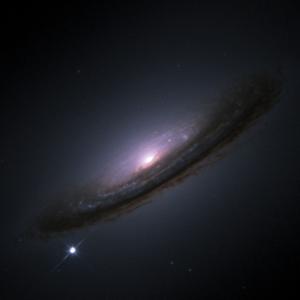The universe has always amazed people. Over time, our understanding of stars and galaxies has changed a lot.
What once looked like unchanging dots in the sky are now known to be stars that live and die in dramatic ways. We have also learned that our galaxy, the Milky Way, is just one of many billions in the universe.
In the sections below, you will learn how we discovered these amazing facts about stars and galaxies, and how our knowledge keeps growing.

- Stars
What we know about stars has changed over thousands of years. Early astronomers recorded the positions and numbers of stars. They did not think that stars could change. The first catalogue of stars was made by Chinese astronomers Gan De and Shi Shenfu around 400 BCE. Astronomers soon realised that 'new stars' could appear in the sky. We know these now as supernovae. The final explosion of a massive star's life. These explosions were so bright that the 'stars' were seen without a telescope. They were only bright for a matter of weeks. One of the most famous was in 1054. This explosion created the Crab Nebula. We still watch this object today, with the help of telescopes, to see what is left after a supernova. During its explosion it was recorded in Chinese, Japanese and Islamic records.
In the 9th – 13th centuries, medieval Islamic astronomers gave names to the stars. We use these names today, e.g., Aldebaran, Betelgeuse, and Rigel. These astronomers built large research observatories to try and learn more about the night sky.
When telescopes came along in the 17th century, it gave us a new way to look at the night sky. Then in the 1800s astronomers used a new tool to look at objects in space, the spectrograph. This tool worked out what things were made of. It was used to look at the Sun, then compare lines in the spectrum with those of known gases. In 1868 this led astronomers, Lockyer and Janssen, to discover a new element in the Sun. It was named helium and wasn’t found on Earth until 1895.
In 1920, Eddington said that stars were powered by the fusion of hydrogen into helium. In 1925, Payne-Gaposchkin showed that there was far more hydrogen and helium in the Sun than there was on the Earth. She said that hydrogen, as the main element in stars, must also be the main element in the Universe. At the time, other scientists thought that the Earth and Sun were made of the same amounts of all the elements. She was later proved to be right but was not given fully credit for her discovery.
During the 20th century a lot was found out about how stars change over time. We call this stellar evolution. In 1913, the Hertzsprung-Russell diagram was made by Danish and American astronomers. This was a massive step forward in learning about how stars change over time. In 1931, Indian-American physicist Chandrasekhar worked out how massive a white dwarf star could be before it exploded. In 1967, Bell Burnell discovered pulsars, which were soon shown to be rapidly spinning neutron stars. Until then, neutron stars had just been theoretical.
It had long been thought that planets could be found around stars other than the Sun. It wasn’t until 1992 that the first one was found. We call these planets, exoplanets, and astronomers have now found over 4000 of them.
- Galaxies
In 964 CE, Persian astronomer Abd al-Rahman al-Sufi was the first to note down 2 nearby galaxies, the Large Magellanic Cloud and Andromeda. Europeans didn't record the Large Magellanic Cloud until the 16th century. At that time people did not know that these objects were galaxies, and called them ‘nebulas’. The word nebula meant a dusty or gassy object. They were thought to be inside the Milky Way.
Also around the 10th century, Arab astronomer Ibn al-Haytham was observing the bright band across the night sky, known as the Milky Way. He realized that the Milky Way was outside the Earth’s atmosphere. Although it was thought that the Milky Way was made up of lots of stars it wasn't until 1610 that Galileo proved this by using a telescope. Herschel later made a diagram to show the shape of the Milky Way and the position of the Sun inside it.
In the 1920s, American astronomer Hubble showed that Andromeda was outside the Milky Way. We now know that Andromeda is another galaxy itself containing billions of stars. There are in fact around 200 billion galaxies in the Universe!
Hubble went on to show that the Universe is also getting bigger. You can recreate Hubble's study using our activity. The fact that it was getting bigger meant scientists could try to work out how old it is. If we could trace is back in time it also suggested the Universe started with a 'big bang’. There has since been lots of evidence to support the this theory.
In the 1970s-80s, scientists Rubin and Ford showed that most galaxies have lots more mass than we thought. We now believe the Universe is made of 4% matter which we can see. This includes the stars, dust and gas. Another 23% is called ‘dark matter’. Dark matter is an invisible mass which we can't see using telescopes. It seems to surround galaxies in a halo. We still don't know what dark matter is made of - but we can see the effect it has by looking at gravity.
This means that we know today only 27% of the Universe is made of matter of some type. The rest is called Dark Energy. This is what causes the Universe to expand. It is an unknown force which acts against gravity. It was first predicted by Einstein. Even today we still have no idea what this force could be.
